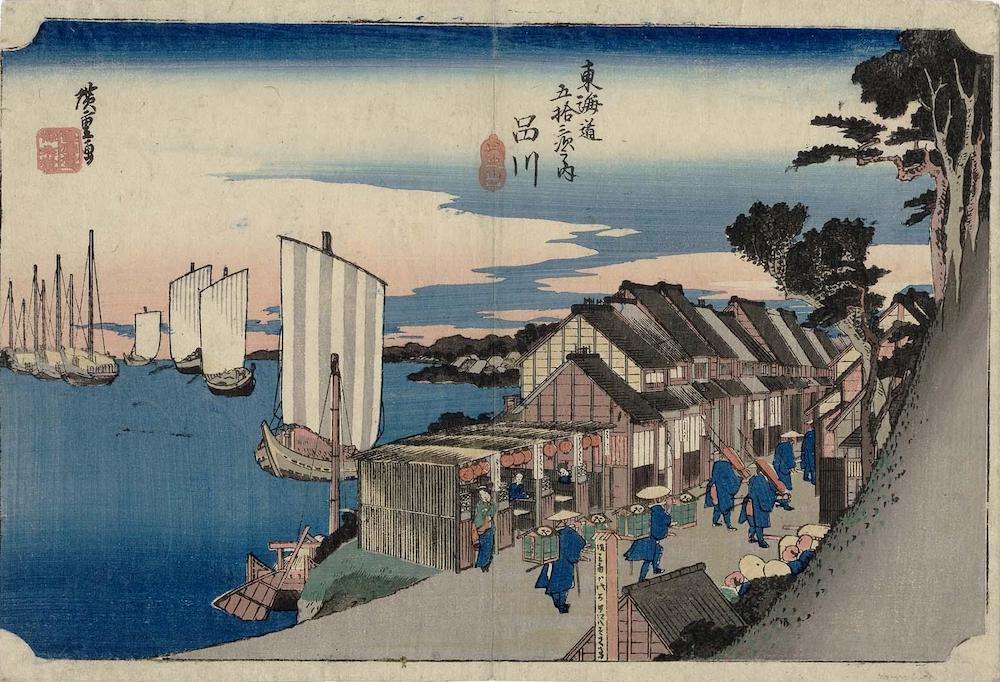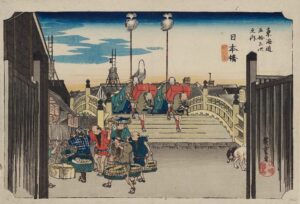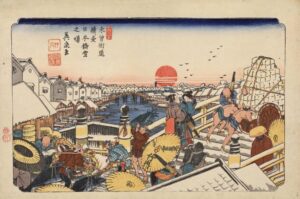The Journey Continues: Shinagawa – Hiroshige’s The First Station on the Tōkaidōa
As you leave Nihonbashi before dawn, the crisp morning air surrounds you. The sensation of straw sandals pressing against the stone pavement reminds you that your journey has only just begun. Before long, the salty scent of the sea drifts through the air.
Arriving at Shinagawa-juku, the first post station on the Tōkaidō, your view suddenly opens up. The vast expanse of sea and sky spreads before you—a welcome contrast to the bustling streets of Edo. To your left, Edo Bay (now Tokyo Bay) stretches out, with gentle waves lapping at the shore. For now, the road follows the coastline, promising a scenic seaside journey ahead.
Encountering a Daimyō Procession
Up ahead, you spot a grand daimyō gyōretsu—a feudal lord’s procession—entering the station town. The samurai, adorned in elaborate robes, march in perfect order. Though much of the procession disappears between the tightly packed houses, its presence is undeniable.
“Move aside, give way!”
Travelers resting by a teahouse rise to their feet and step to the side of the road, respectfully making way for the procession. You follow their lead, pausing to watch. Contrary to popular belief, commoners were only required to bow low or step aside for a passing daimyō. Only the shogunate family and the Three Great Houses of Tokugawa (Owari, Kishu, and Mito) required all to kneel in submission.
“A grand sight, isn’t it?” an elderly man beside you muses.
Across the street, a teahouse mistress leans against her doorway, watching the spectacle with an air of familiarity. In Shinagawa, such events are part of daily life.
The Bustling Station Town
Shinagawa is a lively town where travelers leaving and entering Edo converge. Spanning 2.4 kilometers, the post town boasts 1,600 inns, teahouses, and shops.
“Come on in, take a break!”
Street vendors line the roadside, offering freshly grilled dumplings, while teahouse owners serve steaming bowls of miso soup. Travelers pause for a quick meal before continuing their long journey, while merchants heading towards Edo hurry past, their carts rattling along the stone path.
You take a moment to rest under the eaves of a teahouse, sipping the warm miso soup. The rich umami flavor slides down your throat, bringing comfort to your tired body.
“It’s a long road ahead,” the teahouse owner says with a smile. “Take your time and rest while you can.”
Feeling refreshed, you take another look at the road ahead before setting off once more.
Farewell at the Bridge of Tears
As you leave Shinagawa-juku, a small bridge comes into view—Hamakawa Bridge, also known as Namidabashi, the “Bridge of Tears.”
Here, prisoners were led to the Suzugamori Execution Grounds. Their families, unable to accompany them further, would bid their final, tearful farewells here. The bridge’s name comes from the sorrow of these last goodbyes.
Standing atop the bridge, you pause for a moment. The bustling energy of Shinagawa fades behind you, replaced by a solemn quiet.
Beyond the bridge, the road stretches onward. Your journey has only just begun. Next, you set your sights on Kawasaki-juku, the second post town on the Tōkaidō. As you walk along the coastal road, the sky brightens with the morning sun.
To be continued…
Sunrise at Shinagawa (品川 日之出)
Artist:Utagawa Hiroshige I (初代目歌川広重 (Japanese, 1797–1858))
Publisher:Tsuruya Kiemon (鶴屋喜右衛門)
Date:1834
Medium:Color woodblock print (nishiki-e); ink and color on paper
Dimensions:Horizontal ōban; overall: 9 5/8 × 14 1/8 in. (24.4 × 35.9 cm)
Portfolio:Fifty-three Stations of the Tōkaidō (東海道五拾三次)


